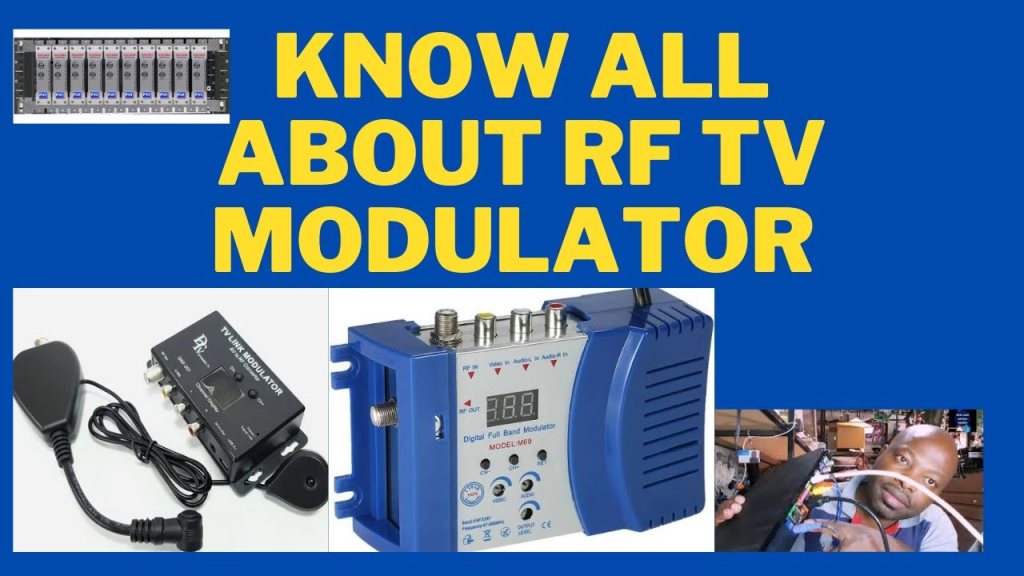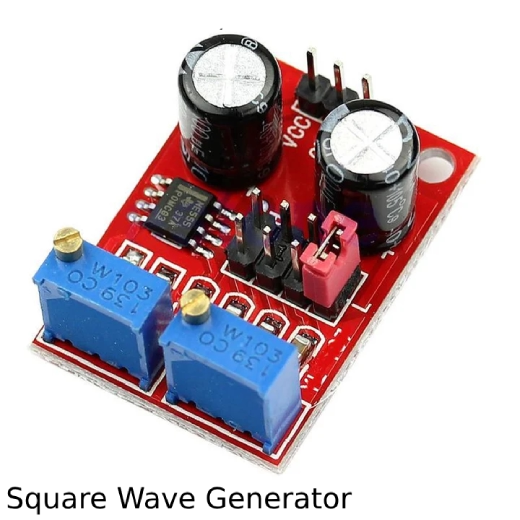

While DVDs and VCRs may belong to a bygone era, many of us still possess these devices. Set-top boxes remain a common choice for television viewing, and a DVD player might still find its place in some households. However, connecting these devices to a TV or screen presents a challenge. Some prefer a wireless setup for convenience. But how does one accomplish this?
When seeking guidance from an expert or browsing through search engines like Google, you might encounter the term ‘RF Modulator.’ Yet, what does it entail? What role does an RF Modulator serve? This article aims to unravel these queries and provide a comprehensive understanding of this technology.
What is Modulation?
When a signal travels across a vast distance, it faces significant losses, leading to considerable damping and information loss by the time it reaches its destination. To mitigate these losses, signal modulation becomes crucial.
Modulation involves blending the signal with a higher-frequency wave. This technique reduces the losses incurred during long-distance wave transmission, extending the potential travel range of the signal. Radio frequency (RF) transmissions, known for their high frequency, excel in transmitting data across extensive distances.
For effective modulation, an RF modulator is essential to encode the signal. Conversely, at the receiving end, the incoming signal needs demodulation to convert it into a usable format. Hence, an RF demodulator is necessary at the signal reception point.
What Is RF Modulator?
RF modulators serve the purpose of transforming signals from devices like VCRs, DVD players, gaming consoles, and media players into a compatible format that can be interpreted by devices designed to receive modulated RF inputs, such as television and radio receivers.
These modulators take the visual or audio outputs from devices like DVD players, camcorders, or gaming consoles and convert them into frequencies assignable to various channels supported by a TV’s cable or antenna input. There exist diverse types of RF modulators, all functioning similarly. They can convert audio and video signals from PAL or NTSC/ATSC composite video, RGB, or other composite AV sources into a broadcast RF signal suitable for connection to a television’s aerial or coaxial connector.
In settings like stadiums, homes, hotels, malls, and airports requiring audio/video distribution, multi-channel RF modulators are commonly employed. These devices feature multiple audio and video inputs alongside one RF output. Source devices like a DSS receiver, DVD player, or VCR connect to the modulator’s audio/video inputs. The modulator is then configured to transmit signals on a specific channel, which the connected TV can receive.
For CATV systems, RF modulation can be intricate. Filters like high pass, low pass, and notch filters are utilized within the modulator to block specific frequencies, enabling the transmission of the source device’s signal on the chosen channel. While consumer-grade modulators might lack residual sideband filtering, commercial-grade modulators used in the CATV sector generally include these features.
In the realm of low-end automotive audio, audio RF modulators find use in linking equipment such as CD changers without requiring dashboard hardware alterations. For instance, a portable CD player’s headphone connector connects to the modulator, which generates a low-power FM radio signal broadcast through the car radio. Challenges related to sound quality and interference are common in car FM modulators. However, these modulators are anticipated to be adopted by devices like MP3 players and similar mobile media players in the near future.
How Does an RF Modulator Work?
An RF Modulator functions through a straightforward mechanism, consisting of three core components:
Input:
Wired connections predominantly serve as the input for RF modulators. These devices link to the input source through a cable, establishing the pathway for the signal.
Signal Modulation:
RF modulators typically accommodate various input standards. Signal modulation is employed to convert the analog signal into a digital format. This transformation enables the signal to be transmitted wirelessly or through cables, adapting it for compatibility with televisions, radios, and other RF receivers, preparing it for output.
Output:
The RF modulator commonly generates two main types of output: Broadcast RF Signal and Cable Signal. The modulated digital signal can either be broadcast over a broad area, accessible to all compatible devices, or delivered directly to a specific device using a coaxial cable.
The purpose of an RF modulator becomes evident from its widespread usage. Its versatility and functionality confirm its usefulness, allowing for the conversion of signals from various sources to formats readable by different devices, thereby facilitating seamless connectivity and signal transmission.
What Is RF Coaxial Cable?
A coaxial cable serves as a transmission line for radio frequency signals and finds versatile applications across various domains. It acts as a conduit for radio transmitters, antennas, Internet connections, digital audio (S/PDIF), and cable television signal distribution. The design of coaxial cables offers distinct advantages in radio transmission.
Unlike other transmission lines, the electromagnetic field carrying the signal exists solely between the inner and outer conductors within an ideal coaxial cable. This unique structure enables coaxial cable runs to be placed near metal objects without significant power losses, distinguishing it from other transmission lines. Moreover, the cable’s construction shields the transmission from external electromagnetic interference.
Comprising an inner conductor surrounded by insulation and a shield—typically woven metallic braid and metallic tape—coaxial cables are further enveloped in an outer insulating jacket. This shield is usually maintained at ground potential, while the center conductor carries the voltage signal. The dielectric material within the cable confines electric and magnetic fields, limiting their leakage outside the shield, a crucial aspect of coaxial cable design.
Various strategies, such as employing larger diameter cables or multiple shields, are used to minimize leakage and interference. Coaxial cables excel in carrying weak signals vulnerable to environmental interference and stronger electrical signals that shouldn’t radiate or interfere with neighboring structures or circuits.
The cable’s characteristic impedance, influenced by factors like the dielectric constant and conductor radius, is crucial for efficient signal transfer. Matching the source and load impedances ensures maximum power transfer and a low standing wave ratio, necessitating a cable with a controlled characteristic impedance.
Other significant characteristics of coaxial cables include attenuation relative to frequency, voltage handling capacity, and shield quality. RF connectors, specifically designed for multi-megahertz radio frequencies, are commonly utilized with coaxial cables to maintain their shielding properties.
Coaxial cables serve as low-loss transmission lines in high-frequency electrical communication, finding application in telephone trunk lines, broadband internet networks, high-speed computer data buses, cable television distribution, and connections between radio transmitters and antennas. Precisely controlled dimensions of the cable and connections are essential for their effective function as transmission lines across various domains, including video CATV distribution, RF and microwave transmission, computer interfaces, and instrumentation data.
How do you convert the coaxial cable to RCA?
To convert a coaxial input to an RCA input, a straightforward approach involves using a VCR device. VCRs typically support both RCA and coaxial connections, allowing for the conversion between the two. If you lack this equipment, you can easily acquire it from local electronics stores or online e-commerce platforms.
Where do you use an RF Modulator?
RF modulators are incredibly pervasive, present in nearly every electronic device. They operate discreetly, transmitting signals across diverse frequencies—some propagate over the internet, while others travel through phone lines. Operating within the radio frequency spectrum, RF modulators boast a broad array of applications. Exploring the question “What is an RF Modulator used for?” unveils their extensive utility.
Reviving Your Aging Gadgets
Many of us own functional but outdated devices—a classic game console, a DVD player loaded with untouched movies, or a video camera holding precious old footage. Unfortunately, these gadgets lack compatible connectors for modern screens.
Yet, there’s a solution: linking these devices to our contemporary TVs using an RF Modulator through radio frequency or coaxial connections. This simple method rejuvenates multiple devices without a hefty investment.
Now, relive nostalgic records, delve into classic games, and revisit your forgotten movie collection on your standard TV. This flexibility extends to older TVs too; an RF Modulator adapts current device signals to match older TV inputs, ensuring compatibility across the board.
Connecting To Multiple Screens Easily
There are moments when we want to share a single signal across multiple screens, like wanting to watch a game from different spots. Dealing with just one TV connection can be frustrating.
But here’s the good news: you don’t need to buy extra cable connections for that one game. Using an RF Modulator, you can distribute the signal from one TV to multiple screens in your home.
Now, enjoy your game anytime without needing to host a crowd! It’s a budget-friendly way to elevate your gatherings without splurging on additional expenses.
Broadcasting A Signal Within Range
Often, there’s a need to broadcast a signal to multiple nearby devices. Directors use this to share camera input across numerous displays for crew viewing. Security camera footage is commonly transmitted using Radio Frequency, employing an RF Modulator. Additionally, it’s beneficial for streaming live games onto stadium displays.
RF Modulators serve as excellent tools for local broadcasting, catering to various needs. Utilizing Radio Frequency, they can amplify and transmit signals within a specific range. This feature enables any device with an antenna to receive and showcase the transmitted signal.
Industrial Applications
Nearly every device holds significance within industrial applications. While you might not immediately perceive its usefulness, delving into the additional information can make you the go-to expert at gatherings.
RF modulators hold extensive relevance in the defense and aviation sectors. Aircraft rely on modulated frequencies, requiring robust RF Modulators to transmit signals effectively. Radars utilize radio frequencies for their transmissions, necessitating powerful RF Modulators to convert and dispatch sensitive radio signals used for aerial detection. This significance extends to television and radio transmissions, employing large-scale RF modulators to convert, amplify, and commercially distribute signals before airing to the public.
How do I use an RF Modulator?
If your setup involves an RF modulator, make sure it’s activated via the on-screen menu and configured to the suitable channel number, typically within the standard TV 21 to 68 UHF channel range.
For a standalone RF modulator box, start by linking a SCART line from your set-top box or recorder to one end and a regular coaxial aerial lead to the other. Then, follow the on-screen prompts to designate a channel number.
Assuming the RF modulator is powered and connected, link the second TV to it using an aerial cable. Proceed to tune the second TV to the specific RF channel number set on the modulator (ranging from 21 to 68 UHF). This channel represents the output akin to a regular television channel.
Conclusion
Now that you grasp the purpose of an RF modulator and how to operate it across various devices, setting up the device and enjoying HD video on your older TVs becomes a swift process.
For further insights into RF modulators or any other electrical components, don’t hesitate to reach out to us at ICRFQ. As premier manufacturers of electrical components in China, we’re committed to delivering top-quality products and assisting with any inquiries you may have.




